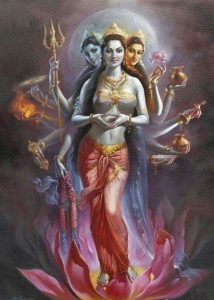Navarathri will soon end, the last day being Vijayadashmi.
If you’ve been observing the rituals of Navarathri, what will you do when it ends?
For most of us celebrating a holiday of religious or spiritual significance, life is resumed with daily activities, work schedules and social engagements almost immediately – until the holiday rolls around again and we start to dig around the cobwebs in our brains to find the nuggets of peace, wisdom and sweetness it had evoked the last time.
Navarathri is no exception. The festivities of the holiday can be so time and effort intensive that by the end of the nine nights, we can be looking forward to returning to “normal life” again. Almost as soon as we put away the dolls and decorations of the golu, we become caught up in the next holiday – Diwali, which follows on the heels of Navarathri. All that we had learned and gained from our days and nights of sadhana can quickly become a thing of the past.
Vijayadashmi
The tenth day of Navarathri is known as Vijayadashmi (vijaya = victorious, dashmi = tenth day). Also known as Dasara, this is the day of celebration of good over evil. Having read the Devi Mahatmyam, we have come to see the great inner battle of divine grace over the three gunas – tamas, rajas and sattva. As Kali, Lakshmi and Saraswati, Shakti destroys the veils of illusion that obscure our true nature as sat-chit-ananda (eternal bliss consciousness). Through her grace, we come to see that this realization of our divine nature is indeed the only true purpose in life. And so we align our desires and our actions with this divine purpose.

Vijayadashmi signifies the parting of the veils of the gunas to reveal our true nature.
It can be just a glimpse, and the veils may come down again to obscure our vision. However, a glimpse, no matter how transient, is significant.
A glimpse transforms belief into faith, an essential ingredient for permanent realization of sat-chit-ananda.
Belief Versus Faith
Belief is defined as acceptance of a statement that something is true.
To believe, we need not have direct experience of the thing that the statement refers to. By definition, belief leaves the possibility that the statement may not be true. If I say that I believe that the earth is round, it means I’ve accepted the statement based on hearsay and I don’t know without a doubt that it is true.
This is the case for spiritual truths as well. I can believe that my true nature is sat-chit-ananda because my teachers or books or others have said so. By definition, however, it means that I don’t really know this with absolute certainty since it is not my direct experience.
Faith, on the other hand, is defined as absolute trust in something.
To have faith is to know without a doubt that something is true. The only time we can be absolutely sure of something is when we have had direct experience of it.
Let me give you an example.
In India, there is a fruit known as seethaphal, also known as sugar apple. (I’m using this example since this fruit is relatively unknown to many!)
Seethaphal is hard to find in temperate climates. There are some die-hard fans of this fruit and its unique taste, which is sugary sweet. If I explained the taste of this fruit to you with anecdotes of how it tasted to me, the experience I had of biting into it and the sugariness of it, you’re going to have to take my word for it. You can read up about it (link above), and talk to others who have tasted it. You now have a belief that seethaphal is delicious, based on hearsay. Since you haven’t tasted it yourself, there’s the possibility that these descriptions are totally false!
On the other hand, if you’ve tasted it, you don’t need to believe any of this. You know. And if you’re like the many who love this fruit, you may look forward to having more of it. Your faith in the taste drives the anticipation.
So too on the spiritual path. A glimpse of our true nature converts belief to faith. Faith, known as shraddha then becomes the drive for progress. We already know that our true nature is sat-chit-ananda, since we have glimpsed it, and so we will do whatever it takes to tear down the obscuring veils permanently.
Faith: The Significance of Vijayadashmi
The Devi Mahatmyam is, in my opinion, the most beautifully apt allegory of the spiritual path. When we progress along the path, we encounter our inner asuras and learn to deal with them with courage, compassion and strength. Our sadhana, in the form of divine grace, gives us the ability to transmute our shadowy asuras into their light-filled counterparts. Along the way, we have glimpses of our own divine nature.
Whether we realize it or not, every single one of us has had this glimpse. If you’ve ever been lost in the sight of a beautiful sunrise, the sound of calm waters, the smell of your baby’s head or the touch of your beloved, your gunas have temporarily been suspended to give you a glimpse of the absolute beauty of being. It’s just that our conditioning is so strong and our minds so busy that these moments are quickly obscured by the constant chatter that makes up our lives.
Spiritual practice makes it possible for us to recognize these glimpses.
With the death of Shumbha and Nishumbha in the Devi Mahatmyam, the author sings of the parting of the clouds to allow the sun to shine through. The sun here represents Self-knowledge, or realizing that who we are is beyond name and form.
The sun shining through is the significance of Vijayadashmi. On this, the last day, we are ecstatic for having had the glimpse of our true nature. Now we know, for faith has replaced belief. Now, our sadhana takes on a new life. It is filled with a different energy – one of anticipation of biting again into the sweet fruit of Self-knowledge.
This is why Vijayadashmi is an extremely auspicious day to take up a new practice. When we make a commitment to take on a new project on this day, it is imbued with sacred energy. I’ve witnessed this in my sadhana. Many years ago, I had the intense desire to learn the Shri Rudram, a Vedic hymn in praise of Lord Shiva. It was during the summer. As it happens, the Rudram is a particularly challenging hymn to learn and memorize, at least for the likes of me. I’d start with the text and invariably get stuck after a few verses. It happened again and again, until I finally gave up. That same year, the desire to learn it arose again on Vijayadashmi. Gingerly, I took it up again. This time, the learning and memorization came easily, and within a few months, it was possible to chant it without difficulty (if interested, here is my chanting of the Rudram and Chamakam).
Vijayadashmi is a great day to start any new project. Its auspiciousness supersedes the limitations of astrological signs and those of time and space. It is a great day to ask Devi for anything, for she will grant it.
Of course, those of us who are insanely devoted to her want nothing but her. On Vijayadashmi, she playfully laughs as she gathers us up in her arms and says, “So be it!”
Image Source: Pinterest
